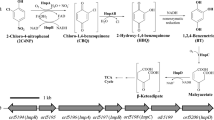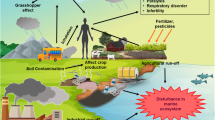Abstract
Commonly used flame retardants, such as polybrominated diphenyl ethers, are extremely persistent in the environment, causing serious environmental risks. Certain strains of bacteria are able to degrade several low brominated congeners of PBDEs aerobically. However, the aerobic degradation pathway is not yet well understood, particularly at the genetic level. In this study, we isolated Cupriavidus sp. WS from the environment that could degrade diphenyl ether (DE), 4-bromodiphenyl ether, and 4,4′-bromodiphenyl ether. DE was completely degraded in 6 days without any detectable end-product. Using transposon mutagenesis, several DE degradation-deficient mutants were obtained. Knocking out bphA1, bphA2, and bphA3 eliminated the ability of the Cupriavidus sp. WS bacterium to degrade DE, indicating that the bph genes play a crucial role in DE degradation by this strain. The specific roles of bphA, bphB, and bphC were identified by systematically expressing these genes in Escherichia coli. The dihydrodiol product of BphA was dehydrogenated into 2,3-dihydroxydiphenyl ether by BphB. 2,3-Dihydroxydiphenyl ether was then decomposed into phenol and 2-pyrone-6-carboxylic acid by BphC. Thus, BphA, BphB, and BphC act sequentially in the aerobic degradation of DE, 4-bromodiphenyl ether, and 4,4′-dibromodiphenyl ether by the Cupriavidus sp. WS bacterium.









Similar content being viewed by others
References
Andrade NA, McConnell LL, Torrents A, Ramirez M (2010) Persistence of polybrominated diphenyl ethers in agricultural soils after biosolids applications. J Agric Food Chem 58:3077–3084
Aziz R et al (2008) The RAST server: rapid annotations using subsystems technology. BMC Genomics 9:75
Canton B, Labno A, Endy D (2008) Refinement and standardization of synthetic biological parts and devices. Nat Biotechnol 26:787–793
Denef VJ, Park J, Tsoi TV, Rouillard JM, Zhang H, Wibbenmeyer JA, Verstraete W, Gulari E, Hashsham SA, Tiedje JM (2004) Biphenyl and benzoate metabolism in a genomic context: outlining genome-wide metabolic networks in Burkholderia xenovorans LB400. Appl Environ Microbiol 70:4961–4970
Ding C, Chow WL, He J (2013) Isolation of Acetobacterium sp. strain AG, which reductively debrominates octa- and pentabrominated diphenyl ether technical mixtures. Appl Environ Microbiol 79:1110–1117
Fortnagel P, Harms H, Wittich R-M, Krohn S, Meyer H, Sinnwell V, Wilkes H, Francke W (1990) Metabolism of dibenzofuran by Pseudomonas sp. strain HH69 and the mixed culture HH27. Appl Environ Microbiol 56:1148–1156
Herrero M, de Lorenzo V, Timmis KN (1990) Transposon vectors containing non-antibiotic resistance selection markers for cloning and stable chromosomal insertion of foreign genes in gram-negative bacteria. J Bacteriol 172:6557–6567
Hirose J, Suyama A, Hayashida S, Furukawa K (1994) Construction of hybrid biphenyl (bph) and toluene (tod) genes for functional analysis of aromatic ring dioxygenases. Gene 138:27–33
Jorundsdottir H, Lofstrand K, Svavarsson J, Bignert A, Bergman K (2013) Polybrominated diphenyl ethers (PBDEs) and hexabromocyclododecane (HBCD) in seven different marine bird species from Iceland. Chemosphere 93:1526–1532
Kim YJ, Osako M, Sakai S (2006) Leaching characteristics of polybrominated diphenyl ethers (PBDEs) from flame-retardant plastics. Chemosphere 65:506–513
Kim YM, Nam IH, Murugesan K, Schmidt S, Crowley DE, Chang YS (2007) Biodegradation of diphenyl ether and transformation of selected brominated congeners by Sphingomonas sp PH-07. Appl Microbiol Biotechnol 77:187–194
Kwan CS, Takada H, Mizukawa K, Saha M, Rinawati SEC (2013) Sedimentary PBDEs in urban areas of tropical Asian countries. Mar Pollut Bull 76:95–105
Lane D (1991) 16S/23S rRNA sequencing. Nucleic acid techniques in bacterial systematics, 125–175
Lee LK, He J (2010) Reductive debromination of polybrominated diphenyl ethers by anaerobic bacteria from soils and sediments. Appl Environ Microbiol 76:794–802
Lee LK, Ding C, Yang KL, He J (2011) Complete debromination of tetra- and penta-brominated diphenyl ethers by a coculture consisting of dehalococcoides and desulfovibrio species. Environ Sci Technol 45:8475–8482
Liaw HJ, Srinivasan VR (1990) Biodegradation of Diphenyl Ethers by a Copper-Resistant Mutant of Erwinia Sp. J Ind Microbiol 6:235–241
Liu YG, Mitsukawa N, Oosumi T, Whittier RF (1995) Efficient isolation and mapping of Arabidopsis thaliana T-DNA insert junctions by thermal asymmetric interlaced PCR. Plant J 8:457–463
Liu YG, Chen Y (2007) High-efficiency thermal asymmetric interlaced PCR for amplification of unknown flanking sequences. Biotechniques 43:649–650, 652, 654 passim
Mohammadi M, Viger JF, Kumar P, Barriault D, Bolin JT, Sylvestre M (2011) Retuning Rieske-type oxygenases to expand substrate range. J Biol Chem 286:27612–27621
Napoli E, Hung C, Wong S, Giulivi C (2013) Toxicity of the flame-retardant BDE-49 on brain mitochondria and neuronal progenitor striatal cells enhanced by a PTEN-deficient background. Toxicol Sci 132:196–210
Nash JT, Szabo DT, Carey GB (2013) Polybrominated diphenyl ethers alter hepatic phosphoenolpyruvate carboxykinase enzyme kinetics in male Wistar rats: implications for lipid and glucose metabolism. J Toxicol Environ Health A 76:142–156
Pfeifer F, Schacht S, Klein J, Truper HG (1989) Degradation of Diphenylether by Pseudomonas Cepacia. Arch Microbiol 152:515–519
Pfeifer F, Truper HG, Klein J, Schacht S (1993) Degradation of Diphenylether by Pseudomonas Cepacia Et4 - Enzymatic Release of Phenol from 2,3-Dihydroxydiphenylether. Arch Microbiol 159:323–329
Pieper DH (2005) Aerobic degradation of polychlorinated biphenyls. Appl Microbiol Biotechnol 67:170–191
Ren XM, Guo LH (2013) Molecular toxicology of polybrominated diphenyl ethers: nuclear hormone receptor mediated pathways. Environ Sci: Processes Impacts 15:702–708
Robrock KR, Coelhan M, Sedlak DL, Alvarez-Cohen L (2009) Aerobic Biotransformation of Polybrominated Diphenyl Ethers (PBDEs) by Bacterial Isolates. Environ Sci Technol 43:5705–5711
Robrock KR, Mohn WW, Eltis LD, Alvarez-Cohen L (2011) Biphenyl and ethylbenzene dioxygenases of Rhodococcus jostii RHA1 transform PBDEs. Biotechnol Bioeng 108:313–321
Sambrook JFE, Maniatis T (1989) Molecular cloning: a laboratory manual, 2nd edn. Cold Spring Harbor Laboratory Press, Cold Spring Harbor
Schmidt S, Wittich RM, Erdmann D, Wilkes H, Francke W, Fortnagel P (1992) Biodegradation of Diphenyl Ether and Its Monohalogenated Derivatives by Sphingomonas Sp Strain Ss3. Appl Environ Microbiol 58:2744–2750
Shih YH, Wang CK (2009) Photolytic degradation of polybromodiphenyl ethers under UV-lamp and solar irradiations. J Hazard Mater 165:34–38
Shih YH, Tai YT (2010) Reaction of decabrominated diphenyl ether by zerovalent iron nanoplarticles. Chemosphere 78:1200–1206
Soderstrom G, Sellstrom U, De Wit CA, Tysklind M (2004) Photolytic debromination of decabromodiphenyl ether (BDE 209). Environ Sci Technol 38:127–132
Stahl LL, Snyder BD, Olsen AR, Walters LS (2013) A national probabilistic study of polybrominated diphenyl ethers in fish from US lakes and reservoirs. Environ Monit Assess 185:10351–10364
Suh YW, Buettner GR, Venkataraman S, Treimer SE, Robertson LW, Ludewig G (2009) UVA/B-induced formation of free radicals from decabromodiphenyl ether. Environ Sci Technol 43:2581–2588
Syed JH, Malik RN, Li J, Wang Y, Xu Y, Zhang G, Jones KC (2013) Levels, profile and distribution of Dechloran Plus (DP) and Polybrominated Diphenyl Ethers (PBDEs) in the environment of Pakistan. Chemosphere 93:1646–1653
Taira K, Hirose J, Hayashida S, Furukawa K (1992) Analysis of bph operon from the polychlorinated biphenyl-degrading strain of Pseudomonas pseudoalcaligenes KF707. J Biol Chem 267:4844–4853
Tokarz JA 3rd, Ahn MY, Leng J, Filley TR, Nies L (2008) Reductive debromination of polybrominated diphenyl ethers in anaerobic sediment and a biomimetic system. Environ Sci Technol 42:1157–1164
Xie Q, Chen JW, Shao JP, Chen CE, Zhao HX, Hao C (2009) Important role of reaction field in photodegradation of deca-bromodiphenyl ether: Theoretical and experimental investigations of solvent effects. Chemosphere 76:1486–1490
Yang M, Qi H, Jia HL, Ren NQ, Ding YS, Ma WL, Liu LY, Hung H, Sverko E, Li YF (2013) polybrominated diphenyl ethers in air across China: levels, compositions, and gas-particle partitioning. Environ Sci Technol 47:8978–8984
Yen JH, Liao WC, Chen WC, Wang YS (2009) Interaction of polybrominated diphenyl ethers (PBDEs) with anaerobic mixed bacterial cultures isolated from river sediment. J Hazard Mater 165:518–524
Zhang Z, Zhang X, Sun Z, Dong H, Qiu L, Gu J, Zhou J, Wang X, Wang SL (2013) Cytochrome P450 3A1 mediates 2,2′,4,4′-tetrabromodiphenyl ether-induced reduction of spermatogenesis in adult rats. Plos One 8:e66301
Zhao HX, Zhang FF, Qu BC, Xue XY, Liang XM (2009) Wet air co-oxidation of decabromodiphenyl ether (BDE209) and tetrahydrofuran. J Hazard Mater 169:1146–1149
Acknowledgments
This study was supported by the National Natural Science Foundation of China (41271335; 31470191), the Major State Basic Research Development Program of China (973 program) (2015CB150502), and the High Technology Research and Development Program of China (863 Program) (2012AA06A203).
Conflict of interest
There is no conflict of interest to report.
Author information
Authors and Affiliations
Corresponding authors
Additional information
Responsible editor: Gerald Thouand
Rights and permissions
About this article
Cite this article
Wang, S., Bai, N., Wang, B. et al. Characterization of the molecular degradation mechanism of diphenyl ethers by Cupriavidus sp. WS. Environ Sci Pollut Res 22, 16914–16926 (2015). https://doi.org/10.1007/s11356-015-4854-3
Received:
Accepted:
Published:
Issue Date:
DOI: https://doi.org/10.1007/s11356-015-4854-3




